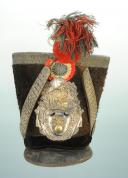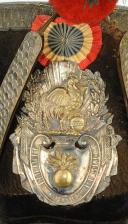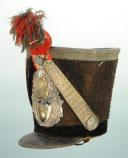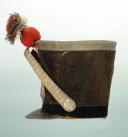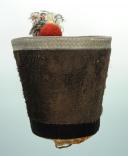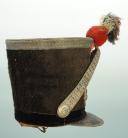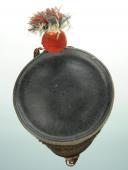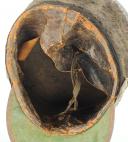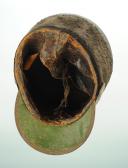
SHAKO D'OFFICIER DE CHASSEUR DE LA GARDE NATIONALE, TYPE 1830, MONARCHIE DE JUILLET.
Sold out
OFFICER SHAKO OF THE NATIONAL GUARD HUSSAR, 1830s TYPE, JULY MONARCHY.
Body made of cardboard covered with silk fabric, 24 cm high, trimmed with a 2.6 cm silver braid at the top and a black velvet band along the base. Black waxed cap with a diameter of 24 cm. Visor made of black waxed leather on the outside and green on the inside, trimmed with a tinned metal wire folded over the outer edge.
Tri-color silk cockade with a diameter of 6.6 cm. Silver-plated copper plate from the 1830s embossed with a radiant sun with oak and laurel branches at the top, and at the bottom, a shield bordered with a ribbon bearing the inscription "LIBERTY PUBLIC ORDER" placed on a bundle of flags. In the center of this plate, two embossed silver-plated brass emblems are attached: in the upper part, the Gallic rooster sitting on Jupiter's spindle and the Earth globe bearing the inscription "FRANCE"; and in the lower part, at the center of the shield, a flaming bomb. Plate height 14.3 cm, width 11.3 cm.
Jugulars composed of a black velvet-covered leather chinstrap entirely covered with a silver-plated copper plate embossed with a series of scalloped scales; and a round rosette stamped in the center with a hunting horn on a sand background bordered by a prominent molding (diameter 3.9 cm). Length of the jugular 22.6 cm.
Interior headpiece made of black waxed leather cut into wolf teeth. Flame pompom with a round part in scarlet wool and a tricolor mixed wool flame.
Good condition, worn visor.
France.
July Monarchy.
PROVENANCE:
Former collection of Hippolyte Marie-Joseph Boivin (Guermantes, September 8, 1857, Bouvresse June 19, 1912).
This scholar from the late 19th century assembled a collection of very important patriotic faience items, which have been exhibited several times in French museums.
A dedicated collector, Hippolyte Boivin gathered faience pieces from Rouen, Marseille, Strasbourg, Delft, Nevers, enameled dial watches from the First Empire, ancient limbs, Norman and Picardian cabinets and clocks, chests and clocks from various periods, tapestries, ratchets from all over France and even abroad.
His grandson recounts that H. Boivin and his wife traveled from village to village, buying all items that seemed of interest to them. These acquisitions enriched his own collections and those of the Beauvais Museum, of which he was the curator from 1889 to 1912. In this collecting endeavor, he also developed a passion for military memorabilia, mainly headgear, copperware, bridle bits, and various historical mementos.
He had a gallery built in his garden to house his military collections, which were later displayed in the "Boivin Hall" at the Dejean barracks (Amiens), destroyed during the Second World War. Hippolyte Boivin showed his preference for patriotic faience by reproducing through drawing and watercolor the pieces he had collected. Two motifs could explain this attraction: first, his family's exile from Champagne during the German invasion of 1870 may have instilled in him a taste for patriotic and military objects; furthermore, his maternal grandfather's profession, operating a stoneware pottery factory in La Chapelle-aux-Pots, may have fostered his love for ceramics.
The objects constituting this knowledgeable enthusiast's collection were all purchased based on opportunities encountered "in the field," and given the collection period: from the fall of Napoleon III until the eve of the Great War, their homogeneity has been carefully maintained.
Body made of cardboard covered with silk fabric, 24 cm high, trimmed with a 2.6 cm silver braid at the top and a black velvet band along the base. Black waxed cap with a diameter of 24 cm. Visor made of black waxed leather on the outside and green on the inside, trimmed with a tinned metal wire folded over the outer edge.
Tri-color silk cockade with a diameter of 6.6 cm. Silver-plated copper plate from the 1830s embossed with a radiant sun with oak and laurel branches at the top, and at the bottom, a shield bordered with a ribbon bearing the inscription "LIBERTY PUBLIC ORDER" placed on a bundle of flags. In the center of this plate, two embossed silver-plated brass emblems are attached: in the upper part, the Gallic rooster sitting on Jupiter's spindle and the Earth globe bearing the inscription "FRANCE"; and in the lower part, at the center of the shield, a flaming bomb. Plate height 14.3 cm, width 11.3 cm.
Jugulars composed of a black velvet-covered leather chinstrap entirely covered with a silver-plated copper plate embossed with a series of scalloped scales; and a round rosette stamped in the center with a hunting horn on a sand background bordered by a prominent molding (diameter 3.9 cm). Length of the jugular 22.6 cm.
Interior headpiece made of black waxed leather cut into wolf teeth. Flame pompom with a round part in scarlet wool and a tricolor mixed wool flame.
Good condition, worn visor.
France.
July Monarchy.
PROVENANCE:
Former collection of Hippolyte Marie-Joseph Boivin (Guermantes, September 8, 1857, Bouvresse June 19, 1912).
This scholar from the late 19th century assembled a collection of very important patriotic faience items, which have been exhibited several times in French museums.
A dedicated collector, Hippolyte Boivin gathered faience pieces from Rouen, Marseille, Strasbourg, Delft, Nevers, enameled dial watches from the First Empire, ancient limbs, Norman and Picardian cabinets and clocks, chests and clocks from various periods, tapestries, ratchets from all over France and even abroad.
His grandson recounts that H. Boivin and his wife traveled from village to village, buying all items that seemed of interest to them. These acquisitions enriched his own collections and those of the Beauvais Museum, of which he was the curator from 1889 to 1912. In this collecting endeavor, he also developed a passion for military memorabilia, mainly headgear, copperware, bridle bits, and various historical mementos.
He had a gallery built in his garden to house his military collections, which were later displayed in the "Boivin Hall" at the Dejean barracks (Amiens), destroyed during the Second World War. Hippolyte Boivin showed his preference for patriotic faience by reproducing through drawing and watercolor the pieces he had collected. Two motifs could explain this attraction: first, his family's exile from Champagne during the German invasion of 1870 may have instilled in him a taste for patriotic and military objects; furthermore, his maternal grandfather's profession, operating a stoneware pottery factory in La Chapelle-aux-Pots, may have fostered his love for ceramics.
The objects constituting this knowledgeable enthusiast's collection were all purchased based on opportunities encountered "in the field," and given the collection period: from the fall of Napoleon III until the eve of the Great War, their homogeneity has been carefully maintained.
Reference :
5667
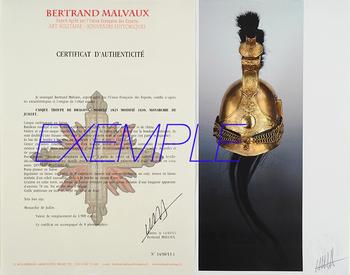
Next update Friday, april 4th at 1:30 PM
FOR ALL PURCHASES, PAYMENT IN MULTIPLE CHECKS POSSIBLE
bertrand.malvaux@wanadoo.fr 06 07 75 74 63
An authenticity certificate of the item including the description published on the site, the period, the sale price, accompanied by one or more color photographs is automatically provided for any item priced over 130 euros. Below this price, each certificate is charged 5 euros.
Only items sold by me are subject to an authenticity certificate, I do not provide any expert reports for items sold by third parties (colleagues or collectors).
